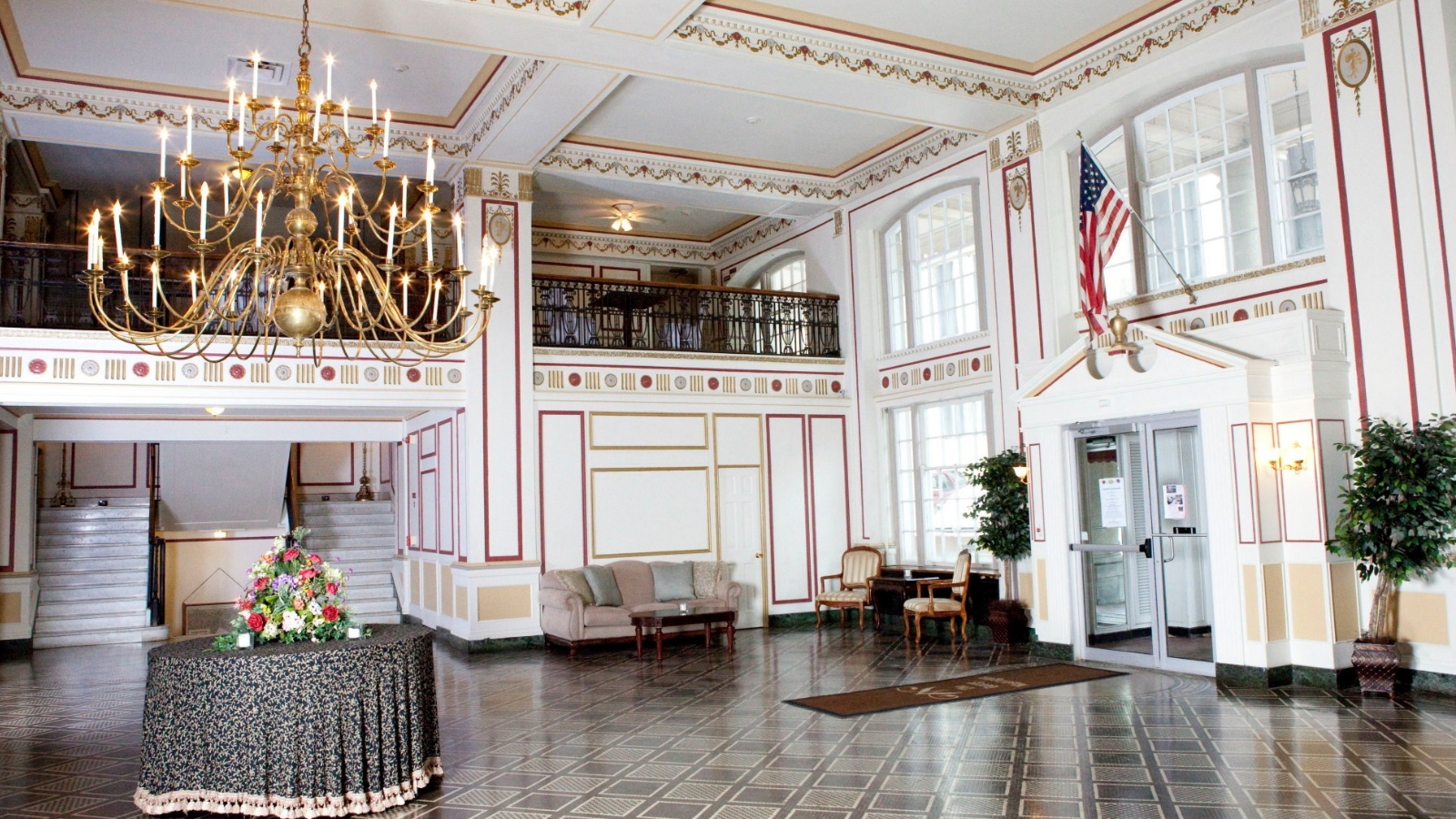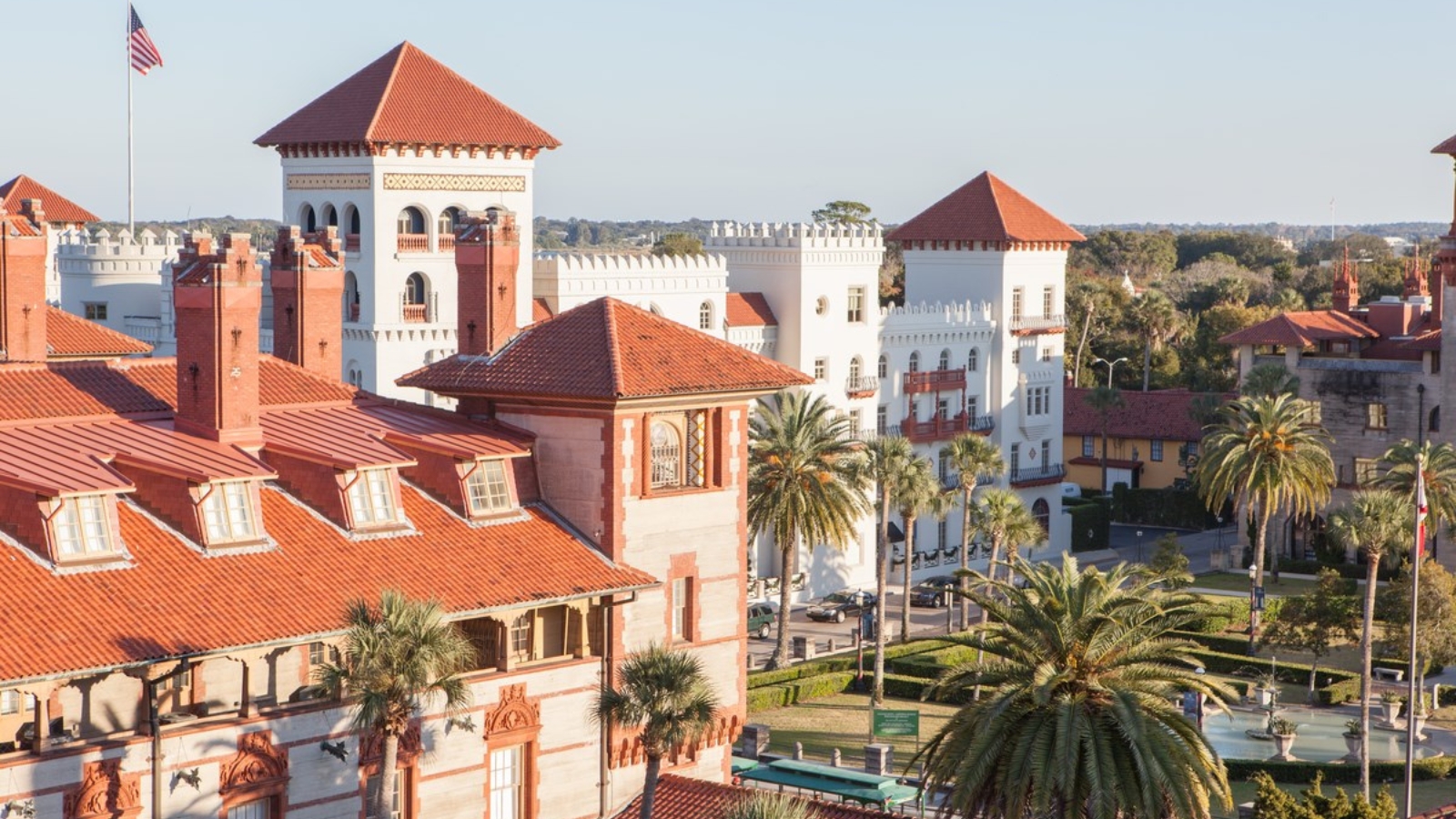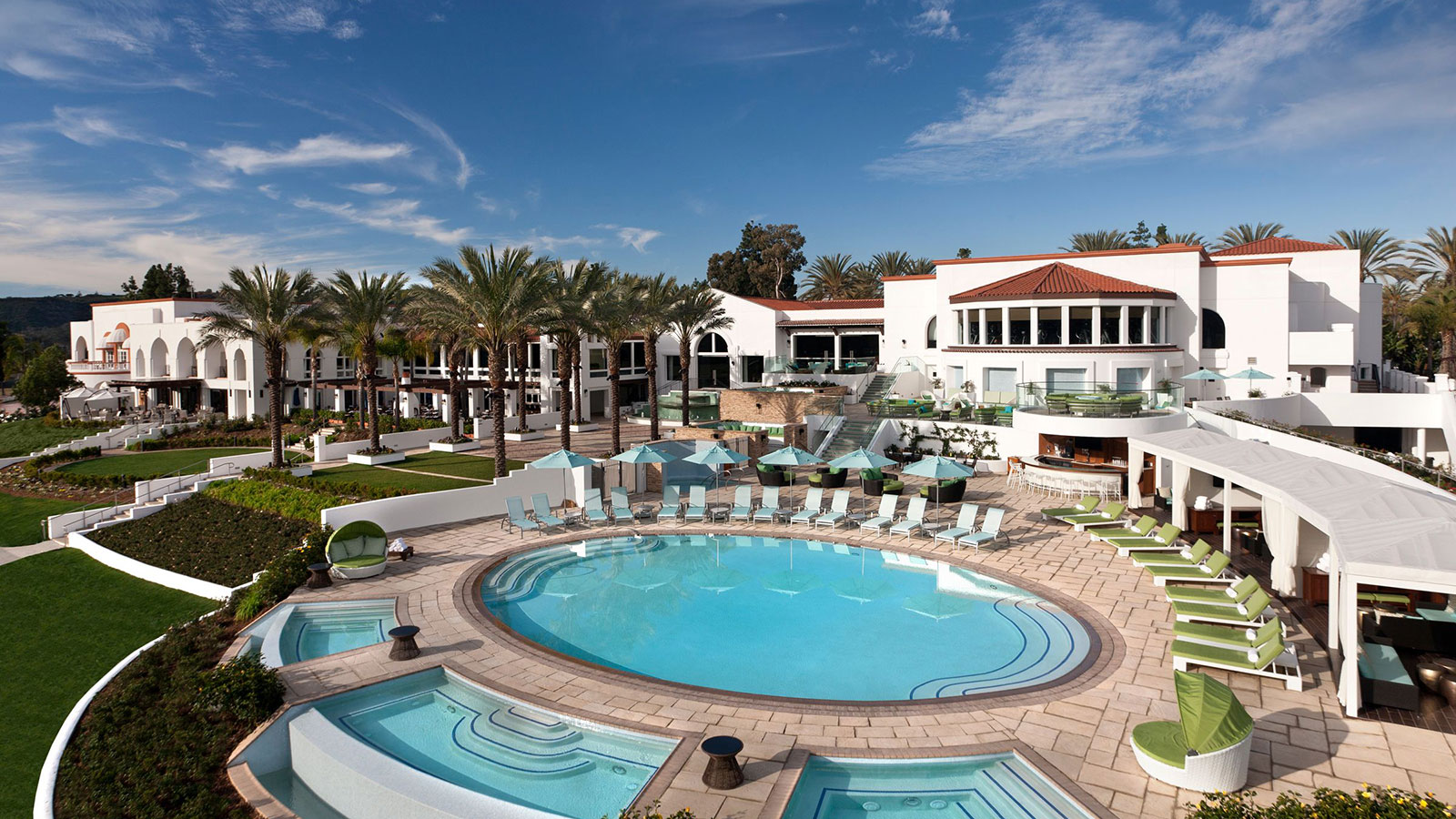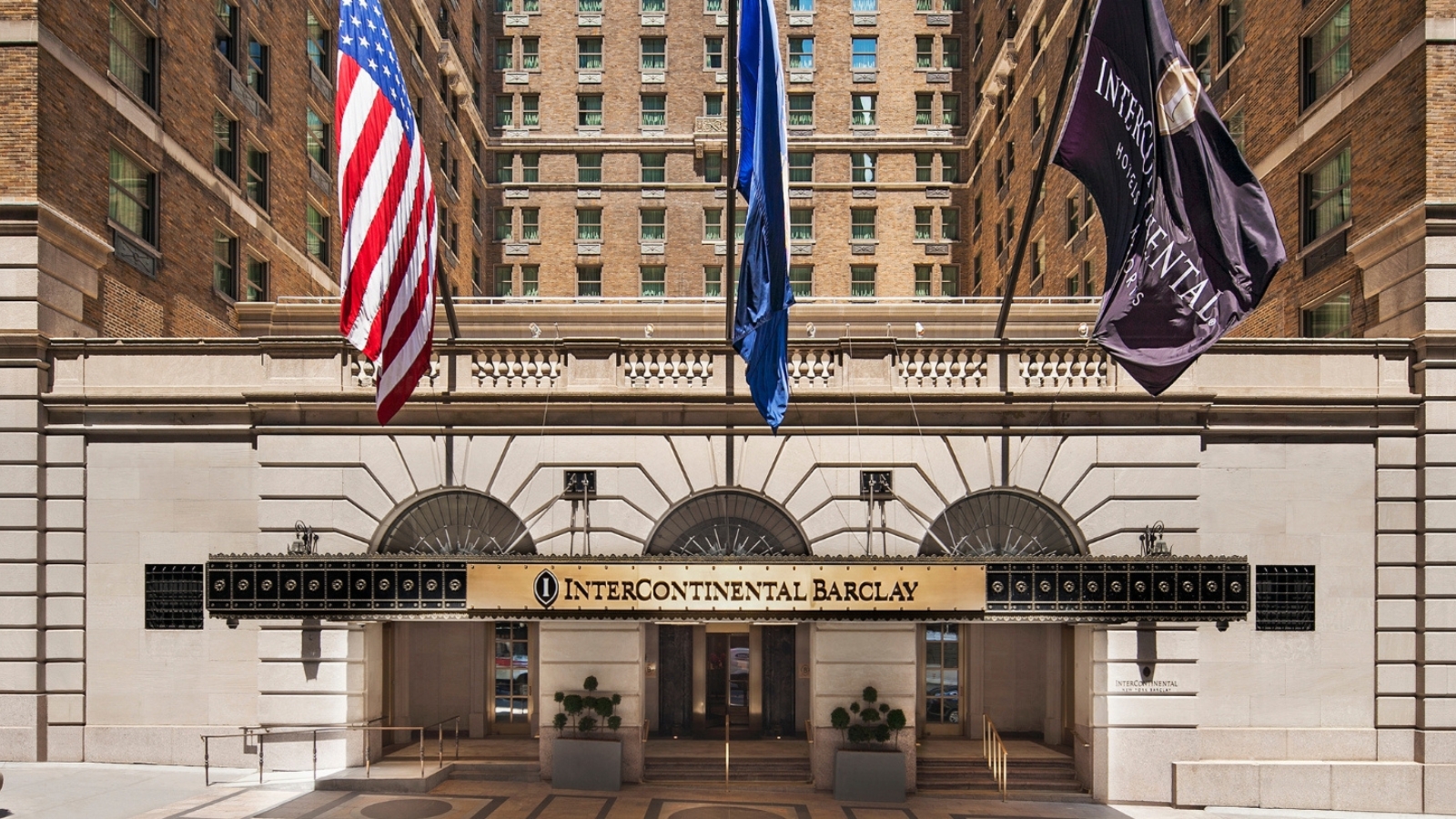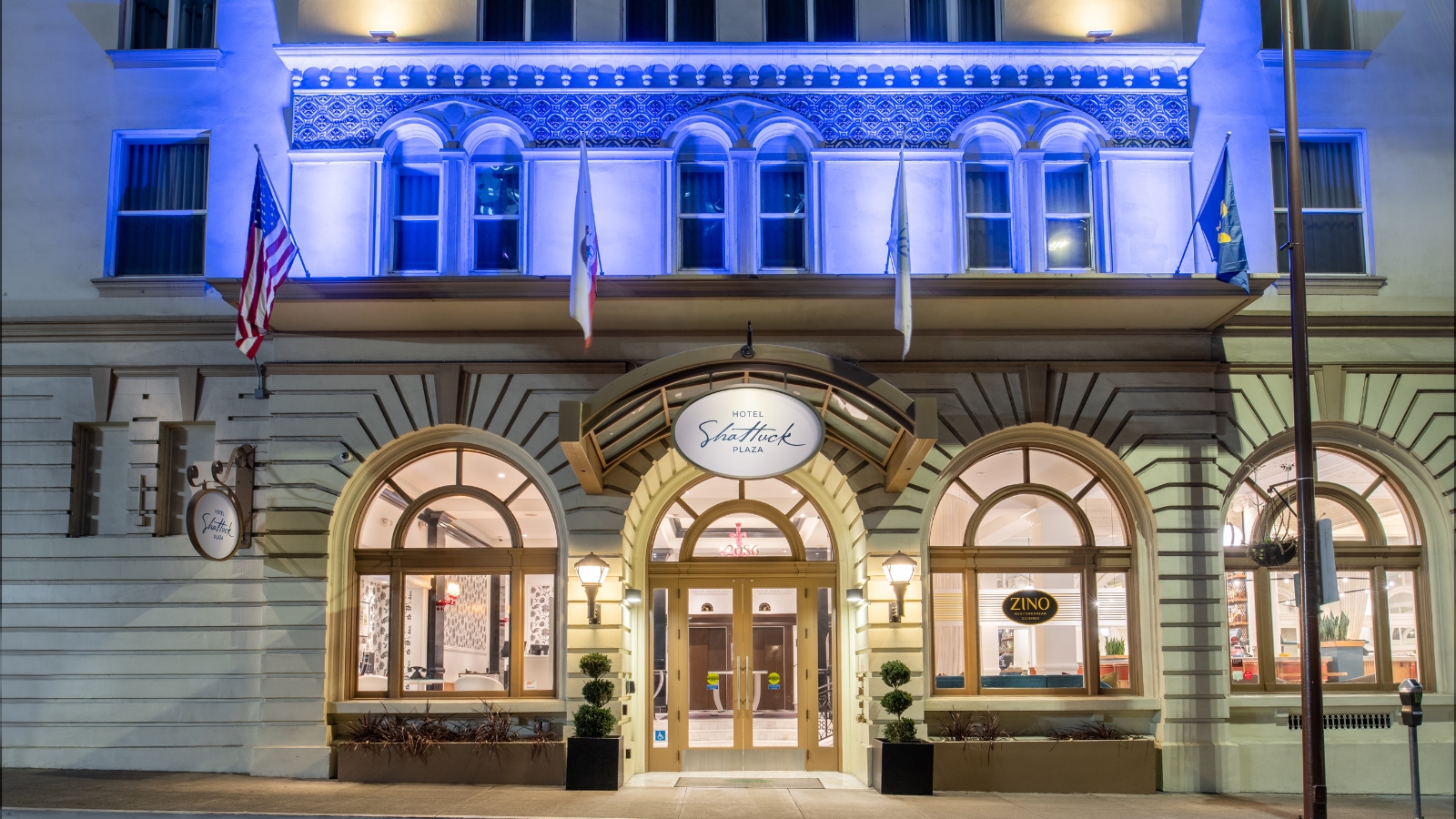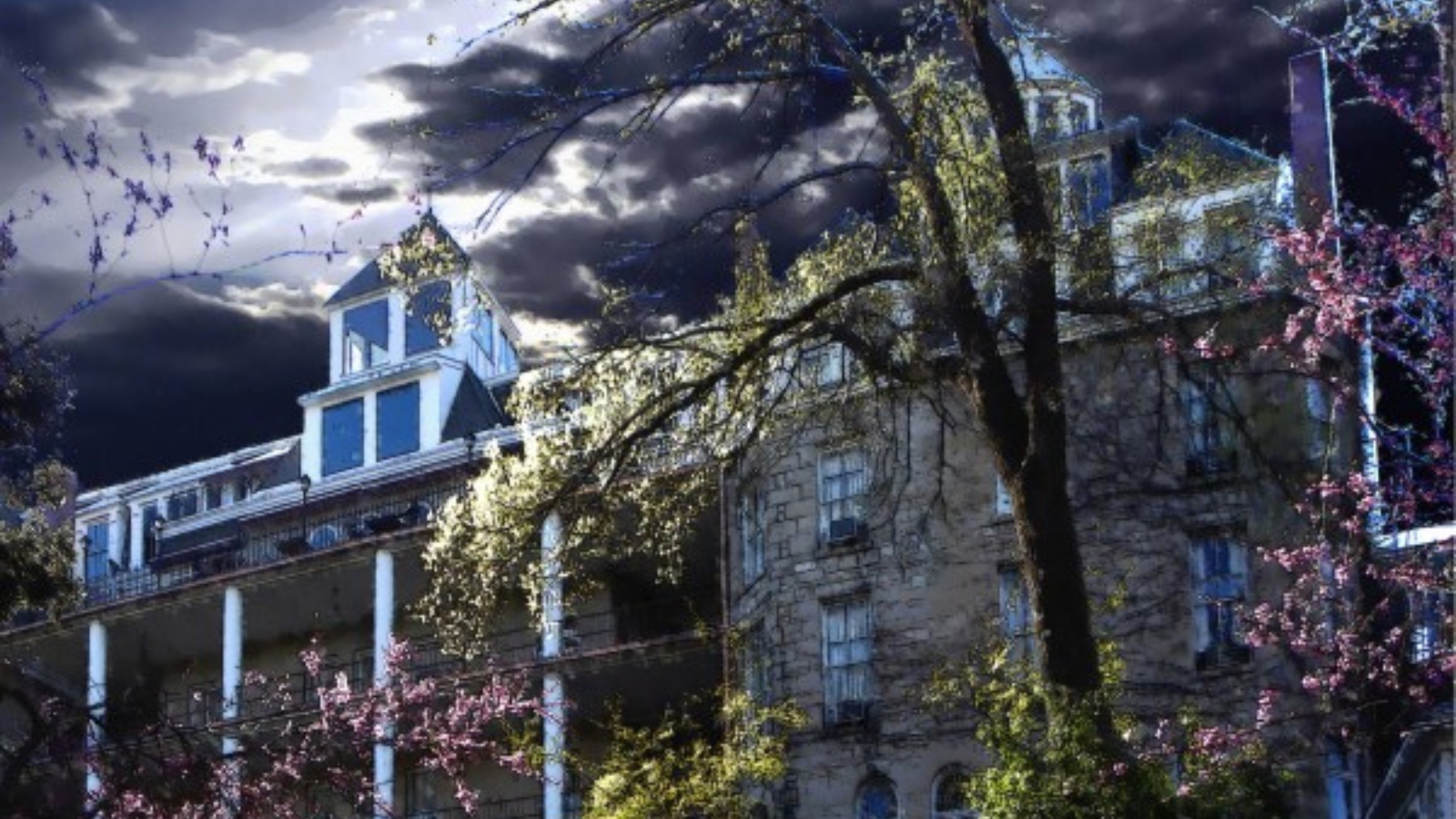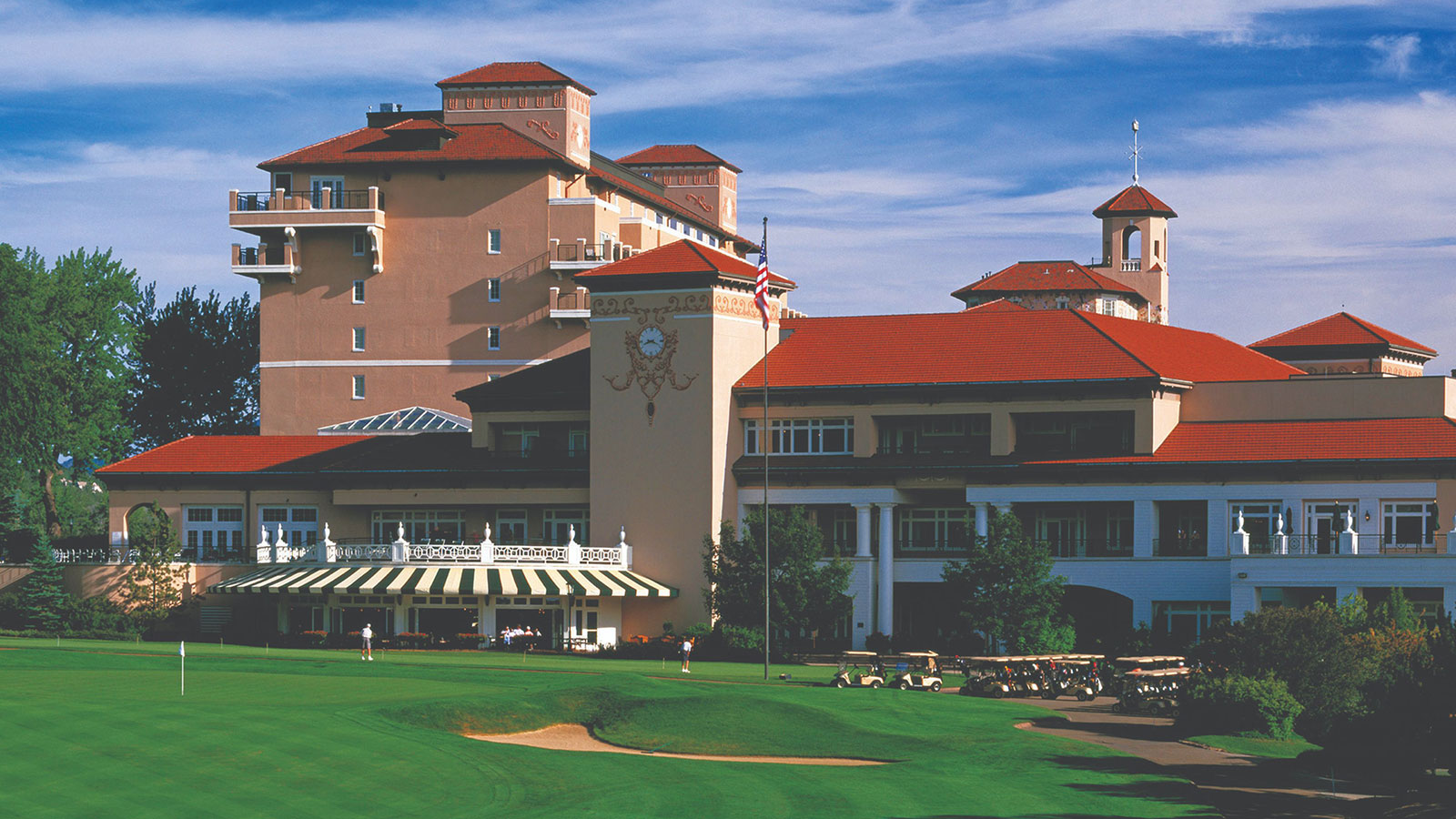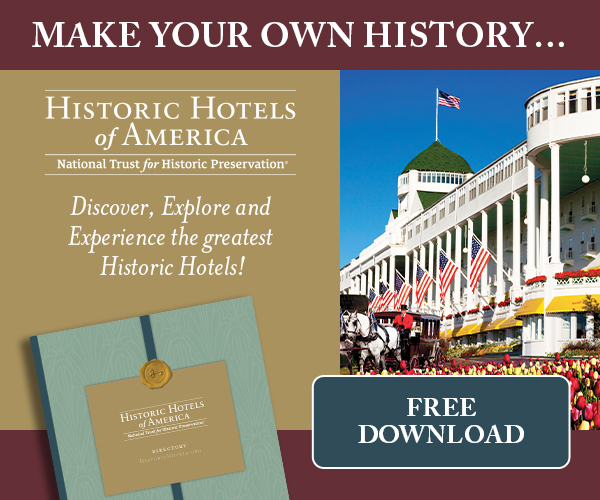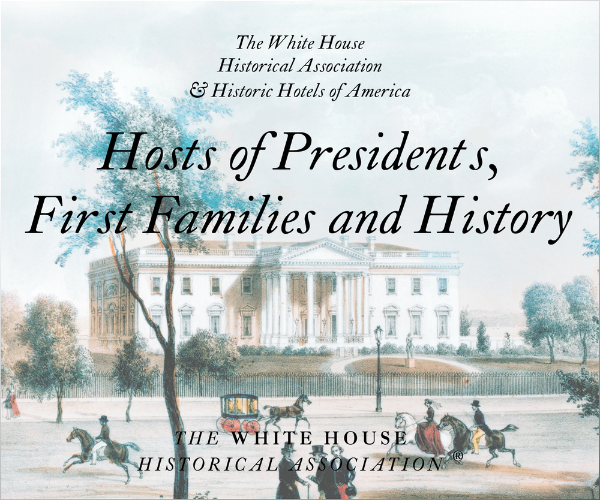Receive for Free - Discover & Explore eNewsletter monthly with advance notice of special offers, packages, and insider savings from 10% - 30% off Best Available Rates at selected hotels.
The 2024 Top 25 Historic Hotels of America® Where U.S. Presidents Made History List Is Announced

The 2024 Top 25 Historic Hotels of America® Where U.S. Presidents Made History List Is Announced
WASHINGTON, DC – January 30, 2024 – Historic Hotels of America, an official program of the National Trust for Historic Preservation, is pleased to announce The 2024 Top 25 Historic Hotels of America Where U.S. Presidents Made History List. The 25 noteworthy historic hotels included on this list illustrate the many ways presidents of the United States of America worked, entertained, relaxed with their families, and made history at historic hotels that are open to the public today. Several historic hotels on this list are sites of international historical significance, such as the hotel where Harry S. Truman signed the United Nations Charter in 1945, and the resort where James Buchanan received the inaugural Transatlantic telegram (from Queen Victoria) in 1858. One historic inn hosted John Adams after signing the Treaty of Paris. Others served as a “Summer White House” or “Western White House,” places where presidents visited often and for extended periods. The hotels presented here are listed or eligible for listing in the National Register of Historic Places, and eight are designated as National Historic Landmarks by the U.S. Secretary of the Interior. These 25 hotels offer their contemporary guests many of the same experiences that American presidents enjoyed while staying at these hotels. Travelers today can visit the historic hotels on this list to reserve a president’s favorite suite or room, play on presidents’ favorite golf courses, dine where presidents enjoyed a meal, swim in the mineral springs where presidents relaxed, and learn more about the cities and towns these presidents stopped in while on the campaign trail.
View The 2024 Top 25 Historic Hotels of America® Where U.S. Presidents Made History Press Release here.
Sign up to receive future news, highlights, and advance notice of special offers from Historic Hotels of America®.
John Rutledge House Inn (1763)
Charleston, South Carolina
 |
The historic John Rutledge House Inn in Charleston, South Carolina, dates to 1763, the start of an era when dissatisfaction and tension grew between England and its colonies in North America. In its early decades, the historic inn was the private home of John Rutledge, a prominent jurist and politician who was instrumental in guiding South Carolina through the American Revolution. Rutledge organized protests against England’s efforts to tax the colonies in the wake of the Seven Years’ War and served as a delegate to the Stamp Act Congress. After the American Revolutionary War and the failure of the Articles of Confederation, Rutledge helped frame the new U.S. Constitution. A vigorous proponent of a strong centralized government, Rutledge was one of the more vocal delegates to the Constitutional Convention of 1787. Though Rutledge never served as president, he was an acquaintance and a political ally of both George Washington and John Adams. The John Rutledge House Inn has the distinct honor of being one of the few surviving historic hotels that hosted President Washington while he was in office. During a tour of the new nation, Washington visited Charleston in 1791 and, although he was often careful to avoid staying in private homes lest he be accused of favoritism, he did visit the Rutledge family home and stayed for breakfast. The second notable presidential visit occurred in the 1920s, when President William Taft—after serving in office—visited his friend, Mayor Robert Goodwyn Rhett. Charleston’s mayor lived at the John Rutledge House Inn and hosted Taft for dinner. This visit is very well-known in the city, in part because it inspired one of Charleston’s classic recipes. Before Taft arrived, Mayor Rhett asked Chef William Deas, butler at the grand house, to “dress up” their typical crab soup. Deas’s presidential variation of the soup featured orange crab eggs, giving the dish a bright color and unique taste—and its name, She-Crab Soup. Guests of the Inn today can enjoy She-Crab Soup just like Taft, and anyone can recreate the historic dish at home with the recipe. Designated a National Historic Landmark by the U.S. Secretary of the Interior, the John Rutledge House Inn is a Charter Member of Historic Hotels of America, founded in 1989. |
Rhineback, New York
 |
The two historic buildings that constitute the Beekman Arms and Delamater Inn in Rhinebeck, New York, have a long and storied history. The Beekman Arms tavern was built in 1766, and played an important role in the American Revolution as it unfolded in the Hudson Valley. During the early 1770s, the 4th Regiment of the Continental Army performed drills on the front lawn of the Beekman Arms tavern, and colonists took refuge here while the British burned the first state capital, Kingston, across the river. After the war, President George Washington and Vice President Aaron Burr—as well as Philip Schuyler, Benedict Arnold, and Alexander Hamilton—all slept, ate, drank, argued about politics, and laughed at the Beekman Arms tavern. In the 1840s, the Delamater Inn was built a block away. In 1888, when Benjamin Harrison was nominated for president, he and his running mate, Vice President Levi P. Morton, assembled their supporters in the Delamater Inn when they learned that they had been selected by the Republican Convention. Harrison won the election that year, becoming the 23rd President of the United States. In the 20th century, President Franklin D. Roosevelt—who called the Hudson Valley home for many years—was a frequent guest at the Beekman Arms. Roosevelt was responsible for the construction of the nearby Rhinebeck Post Office, which was built by the Works Progress Administration during the Great Depression. Roosevelt concluded each of his political campaigns for governor and president with a public address from the tavern’s front porch. Other Vice Presidents who have visited include Nelson Rockefeller and Al Gore. The Beekman Arms and Delamater Inn was inducted into Historic Hotels of America in 2006.
|
Hot Springs, Virginia
 |
Best known for its historic championship golf courses and natural Warm Springs Pools, The Omni Homestead Resort in Hot Springs, Virginia, has offered rest and relaxation to U.S. Presidents for over 200 years. Two major springs from the Allegheny Mountains flow through the resort, and separate men’s and women’s bathhouses allow visitors to soak in the natural mineral waters. In the 1750s, George Washington traveled through the region a few times, and historians suspect, but cannot officially determine, that he bathed in the springs in 1756. Washington’s visit was followed more than 60 years later by an aging Thomas Jefferson, who sought relief there in 1818 for his rheumatoid arthritis. The trip proved to be so uplifting that Jefferson praised the entire location as being one of the best places to vacation in the whole country. Other presidents followed: President James Madison; President Martin Van Buren and his son; President John Tyler and First Lady Julia Tyler visited twice; President Millard Fillmore; President Franklin Pierce and First Lady Jane Pierce; President Benjamin Harrison and First Lady Caroline Harrison; President William McKinley and First Lady Ida McKinley; President Herbert Hoover; Harry S. Truman and First Lady Bess Truman; President Richard Nixon; Gerald Ford; George H.W. Bush and First Lady Barbara Bush. President William Howard Taft and his family stayed at the resort for months at a time in the early 20th century. Woodrow Wilson honeymooned at the resort with First Lady Edith Wilson in 1915. President Franklin D. Roosevelt celebrated the Fourth of July at the resort in 1931. Dwight D. Eisenhower was a frequent visitor who stayed before, during, and after being in office. Ronald Reagan and Jimmy Carter both visited (separately) to attend meetings during their terms as governors of California and Georgia, respectively. In addition to enjoying the Warm Springs Pools, many of these presidents and first ladies played on the resort’s two famous golf courses, the Old Course and The Cascades. Notably, William McKinley was the first U.S. President to play golf while in office, and he did so on the Old Course, teeing off in 1899. While enjoying their honeymoon, Woodrow Wilson and Edith Wilson played golf together each morning on the Old Course, and Jacqueline Bouvier learned to play golf on The Cascades as a young girl in the 1930s. The historic resort offers five Presidential Suites named after Madison, McKinley, Taft, Wilson, and Eisenhower. In the Lobby Bar, guests can discover 23 portraits by Paul Bertholet that represent each president who has been a guest of the Resort. Designated a National Historic Landmark by the U.S. Secretary of the Interior, The Omni Homestead Resort is a Charter Member of Historic Hotels of America, founded in 1989. |
Annapolis, Maryland
 |
Three historic 18th-century Inns make up the Historic Inns of Annapolis, a charming trio located in the heart of Annapolis, Maryland, across the street from the Maryland State House. The Governor Calvert House and Robert Johnson House were established first as private homes, but since 1772, the Maryland Inn has hosted politicians visiting the city. Annapolis briefly became the capital of the United States of America under the Articles of Confederation. On September 3, 1783, the Treaty of Paris that ended the war between England and its former colonies was ratified by George Washington at the Maryland State House, a block away from the Maryland Inn. This document was signed at the State House by diplomat and inventor Benjamin Franklin, 6th President of the Continental Congress John Jay, and future president John Adams. After the peace treaty was ratified, the three Founding Fathers retired to the tavern at the Maryland Inn to celebrate. The Maryland Inn’s tavern is today an event space and restaurant named The Treaty of Paris in honor of that history. Historic Inns of Annapolis are contributing structures to the Colonial Annapolis Historic District, listed in the National Register of Historic Places, and were inducted into Historic Hotels of America in 1996. |
Bedford, Pennsylvania
 |
On August 16, 1858, Queen Victoria sent the very first telegram over the newly built Transatlantic telegraph cable. Sitting President James Buchanan received it at his favorite “Summer White House,” the Omni Bedford Springs Resort in Bedford, Pennsylvania. From his Sheraton desk at the historic resort hotel, Buchanan read:
London, England: Come let us talk together. American genius and English enterprise have this day joined together the Old and the New World. Let us hope that they may be as closely allied in the bonds of peace, harmony, and kindred feeling. Signed, Victoria R. Buchanan responded: Bedford Springs: New England accepts with gladness, the hand of fellowship proffered by Old England, and if ever discord of diversity of interest should threaten this alliance, let our language be, “entreat me not to leave thee, or return from following thee, for the interests of thy people shall be the interests of my people, and thy God shall be my God.” Signed, James Buchanan, President, U.S.A. It was an international achievement, marking the moment when messages could travel thousands of miles in minutes, instead of days or weeks. After forty messages were sent over three days, the first working Transatlantic cable failed, and eight years passed before a new cable was completed. The 15th President of the United States, James Buchanan, ran his campaign for office from Bedford Springs. Many important papers were signed at Bedford Springs on a Sheraton desk, which he refused to let the hotel dispose of; he maintained that the drawers were just the right size for his shirts. In all, the popular Pennsylvania bachelor president spent 25 summers at the resort. Other presidents who have visited the Omni Bedford Springs Resort include Thomas Jefferson, Andrew Jackson, William Henry Harrison, John Tyler, James K. Polk, Zachary Taylor, James Garfield, Dwight D. Eisenhower, William Howard Taft, and Ronald Reagan. On a guided history tour of the resort, guests can view historical photos, record books, and even James Buchanan’s desk in the lobby. The Omni Bedford Springs Resort is designated a National Historic Landmark by the U.S. Secretary of the Interior, and was inducted into Historic Hotels of America in 2008. |
Mobile, Alabama
 |
Established in 1852 in the rapidly expanding port city of Mobile, Alabama, the Battle House Renaissance Mobile Hotel & Spa is a must-see for anyone traveling through the city on a tour of the Gulf Coast. Many illustrious guests visited the “Battle House Hotel” over the years, including the likes of Senator Henry Clay, General Winfield Scott, and U.S. President Millard Fillmore. In 1860, Senator and presidential candidate Stephen A. Douglas spent Election Night inside the hotel. The present-day site of the Battle House Renaissance Mobile Hotel & Spa was once the headquarters of General—and future U.S. President—Andrew Jackson during the War of 1812. The most significant presidential visit was by President Woodrow Wilson in 1913. During his visit to Mobile, members of the Southern Commercial Congress held a “Presidential Breakfast” in his honor with nearly 200 guests in attendance. Hotel staff at the time recalled how seemingly countless Secret Service agents had sprawled across the building’s interior. Afterward, Wilson traveled a block south to the Lyric Theatre, where he gave a speech repudiating the Monroe Doctrine as a means of appeasing the country’s Latin American allies. It was here that President Wilson gave his now-famous remark: “The United States will never again seek one additional foot of territory by conquest.” The Lyric Theatre was demolished in the 1950s, but the elegant historic hotel is still welcoming guests after 172 years. Listed in the National Register of Historic Places, the Battle House Renaissance Mobile Hotel & Spa was inducted into Historic Hotels of America in 2009. |
San Antonio, Texas
 |
When The Menger Hotel opened on February 1, 1859, it was hailed as “the finest hotel west of the Mississippi River.” Since then, the San Antonio, Texas, hotel has hosted U.S. Presidents, including Ulysses S. Grant, Theodore Roosevelt, William McKinley, William Howard Taft, and Dwight D. Eisenhower. The Menger Hotel is best known for its ties to Theodore Roosevelt, who visited before, during, and after his time in office. In 1892, Teddy Roosevelt visited The Menger Hotel at age 29 while on a trip to hunt javelina, a pig-like animal. In 1898, he returned with Colonel Leonard Wood to organize the first U.S. Volunteer Calvary, the “Rough Riders,” who fought in Cuba during the Spanish-American War. When the Rough Riders trained in San Antonio, Roosevelt and his soldiers were known to gallop their horses up to the hotel entrance. In 1905, when Roosevelt was President, he and the Rough Riders returned to The Menger Hotel for an elegant reunion banquet. Today, guests can reserve the hotel’s Roosevelt Luxury Suite, which features decor and memorabilia related to the president’s life and his time at the hotel. Visitors at the hotel’s Roosevelt Bar can view a collection of photographs of its namesake. One legend suggests that Roosevelt occasionally haunts the bar. The Menger Hotel brings Roosevelt to life for visitors, too, through an annual show put on by Joe Wiegand, a Theodore Roosevelt Reprisor. During Wiegand’s show, he takes on the persona of the President, and shares stories of his time in San Antonio recruiting the Rough Riders, his path to the White House, and his land conservation legacy. The Menger Hotel was inducted into Historic Hotels of America in 1989 and is a Charter Member. |
San Francisco, California
 |
When the Palace Hotel opened in 1875, it was San Francisco’s first luxury hotel, and the largest hotel in the world. The first U.S. President to visit the hotel was Ulysses S. Grant in 1875, and 19 presidents followed him, 13 of whom stayed in the hotel’s Presidential Suite: Rutherford B. Hayes, Grover Cleveland, Benjamin Harrison, William McKinley, Theodore Roosevelt, William Howard Taft, Woodrow Wilson, Warren G. Harding, Franklin D. Roosevelt, Harry S. Truman, Dwight D. Eisenhower, John F. Kennedy, Richard Nixon, Gerald Ford, Jimmy Carter, Ronald Reagan, George H.W. Bush, Bill Clinton, and Barack Obama. Of great historical significance was President Woodrow Wilson’s visit in 1919, when he hosted two luncheons at the Palace Hotel to garner support for the Treaty of Versailles to end World War I. Wilson also advocated for the creation of the League of Nations during these meetings. Decades later, when the United Nations was chartered in San Francisco, the hotel hosted a grand soiree in The Garden Court to honor the opening session of the new international body in 1945. President Harry S. Truman was present for this historic event. The Palace Hotel manages its own museum to share stories from its past with visitors. At the Landmark 18 Museum and Gallery, photographs, artifacts, and one-of-a-kind memorabilia left or donated by honored guests are on display. Within the museum, there is a dedicated exhibit for the presidents who have visited and resided at the Palace Hotel since its opening. In February 2022, in honor of Presidents’ Day, the Palace Hotel's Pied Piper Bar debuted a Presidential Cocktail Menu. This menu shares historical anecdotes of each of the 20 presidents and dignitaries who have visited the Palace Hotel and showcases their beverage of choice. The Palace Hotel was inducted into Historic Hotels of America in 2010. |
Riverside, California
 |
The Mission Inn Hotel & Spa in Riverside, California, dates to 1876 and is likely the most romantic historic hotel in Presidential History. In its first few decades, the small inn developed into a stunning European-style hotel with expansions and additions including castle-like towers, Mediterranean-Revival-style domes, flying buttresses, sprawling arcades, and great works of art. Starting with Benjamin Harrison in 1891, ten U.S. Presidents have visited the Hotel. Of the ten, two did so before they occupied the Oval Office. Glamorous and romantic, The Mission Inn Hotel & Spa was the destination of choice for the Reagans and the Nixons to celebrate their marriages. Richard Nixon married Patricia Nixon at The Mission Inn Hotel & Spa on June 21, 1940. The hotel venue where they took their vows is now known as the Presidential Lounge. Just over a decade later, future President Ronald Reagan and First Lady Nancy Reagan spent part of their honeymoon at The Mission Inn Hotel & Spa in March 1952. Today, The Mission Inn Hotel & Spa is still a beautiful location for a wedding or romantic getaway. With several sumptuously appointed chapels, ballrooms, and galleries, and with options for outdoor ceremonies and receptions, brides and grooms can celebrate their weddings like these presidents and first ladies at The Mission Inn Hotel & Spa. For a romantic getaway, book the Alhambra Suite where the Reagans stayed on their honeymoon. The Mission Inn Hotel & Spa was designated a National Historic Landmark by the U.S. Secretary of the Interior, and it was inducted into Historic Hotels of America in 1996. |
Jekyll Island, Georgia
 |
Nestled on a barrier island off the coast of Georgia, the Jekyll Island Club Resort opened in 1887 as a hunting retreat for America’s wealthiest families. Naturally, an assemblage of the nation’s most powerful families brought presidents to the island for rest and relaxation over the years. The most celebrated presidential visit at the Jekyll Island Club Resort was that of President William McKinley in 1899. Invited by Cornelius Newton Bliss, an original member of the Club and then the U.S. Secretary of the Interior, McKinley's visit was not just a leisurely retreat. McKinley’s visit became a significant political event, drawing media attention due to the presence of Thomas B. Reed, 32nd Speaker of the United States House of Representatives, marking a critical moment in the lead-up to the presidential campaign of 1900. This visit symbolized the convergence of political power and social prominence, firmly establishing the Jekyll Island Club as a nexus of influence. Another important historical connection between the historic resort and a sitting U.S. President is found in the history of the telephone. In 1915, President Woodrow Wilson answered the nation’s first transcontinental phone call. On that historic call was Wilson in Washington, DC, Alexander Graham Bell in New York, Thomas Watson in San Francisco, and AT&T President Theodore Newton Vail at the Jekyll Island Club Resort. Today, visitors of the Jekyll Island Club Resort can learn about the presidents who visited the resort through its history wall, plaques, programming, and historical thematic offerings including menus, packages, and rooms. Jekyll Island Club Resort was inducted into Historic Hotels of America in 1994 and was named one of America’s Dozen Distinctive Destinations by the National Trust for Historic Preservation in 2003. |
Durango, Colorado
 |
An iconic and refined “Old West” hotel, The Strater Hotel is centrally located in Durango, Colorado, just two blocks from the historic Durango & Silverton Narrow Gauge Railroad, and has a place in the histories of two U.S. Presidents. First, The Strater Hotel entertained then-Senator John F. Kennedy in June 1960, as he was making campaign stops in the Southwest. At the time, Durango was hosting the Colorado Democratic Convention at the Fort Lewis College gym on Saturday, June 18, 1960. Kennedy stayed at The Strater Hotel in Room 322 and delivered a speech in the hotel's Pullman Room. The Presidential visits of President Gerald Ford were of greater significance to the region, who stayed frequently at The Strater Hotel between 1979 and 1997. Ford was drawn to Durango after serving as President when he and his business partner, Leonard Firestone, purchased local Durango radio stations in 1979. Ford visited Durango three times between 1979 and 1997. He and his wife stayed in Room 333 at The Strater Hotel on two of these visits. On his first trip, he came to Durango for the transfer of ownership of these radio stations. On his second trip, he came to celebrate Durango’s Centennial on August 13, 1980. During that visit, Ford joined a parade on Main Avenue with Colorado Governor Richard Lamm and former Durango Mayor Ian Thompson. Today, Room 333 is dedicated to President Ford and visitors can book a stay in this special guestroom. Kennedy’s visit to the hotel is honored by the photographs on display in the Pullman Room. The Strater Hotel is a Charter Member of Historic Hotels of America, founded in 1989. |
 |
The Brown Palace Hotel and Spa, Autograph Collection has hosted presidents, celebrities, and royalty during their visits to Denver, Colorado, for over 130 years. Nearly every U.S. President since Teddy Roosevelt has visited The Brown Palace Hotel. While in office, Presidents Woodrow Wilson, Warren G. Harding, Franklin D. Roosevelt, Dwight D. Eisenhower, Bill Clinton, and George W. Bush stayed at the hotel. Richard Nixon, Gerald Ford, and George H.W. Bush all stayed at The Brown Palace Hotel while serving as Vice President. Herbert Hoover, Harry S. Truman, and Jimmy Carter all stayed at The Brown Palace Hotel after their terms in office. President Dwight D. Eisenhower was the hotel’s most frequent presidential visitor. Eisenhower maintained a campaign office at The Brown Palace Hotel in 1952, and returned frequently during his time as President, sometimes staying as long as six weeks at a time. The Brown Palace Hotel became known as “The Western White House" during Eisenhower’s presidency, and today, visitors can reserve the Eisenhower Suite. This is the same suite where Eisenhower and First Lady Mamie Eisenhower spent the summer of 1955, and today, the suite highlights the special connection that the President had with the hotel. Fully renovated since the Eisenhowers stayed at The Brown Palace Hotel, a new tribute wall showcases letters, photos, and mementos from Eisenhower. The Federal Style suite is appointed with rich blue carpeting, elegant draperies, formal furniture, and spectacular white columns. There is a dent in the fireplace mantel, but it is part of its charm: Eisenhower nicked it while practicing his golf swing. Other themed presidential suites at the historic hotel are the Reagan Suite and the Roosevelt Suite. Public and private tours, led by the hotel’s in-house historian, Debra Faulkner, are available and showcase the presidential suites. The Brown Palace Hotel and Spa, Autograph Collection is a Charter Member of Historic Hotels of America, founded in 1989. |
Glenwood Springs, Colorado
 |
A 19th-century replica of the famous 16th-century Villa Medici in Rome nestled high in the Rocky Mountains, Hotel Colorado has welcomed presidents, celebrities, luminaries, silver barons, and even gunslingers, since it opened in 1893 in Glenwood Springs, Colorado. In fact, many presidents have visited Hotel Colorado over its 130-year history. President Theodore “Teddy” Roosevelt visited multiple times, with two notable stays in 1901 and 1905. Then-Vice President Roosevelt visited the hotel during a hunting trip to the region in January 1901. Four years later, Hotel Colorado was dubbed “the little White House of the West” when President Teddy Roosevelt and his staff returned for a three-week bear hunting expedition, during which he also attended to business of state. According to a popular legend, one of the most recognizable children’s toys for over a century, the Teddy Bear, was created at Hotel Colorado during this 1905 visit. To cheer up President Roosevelt after an unsuccessful day of hunting bears, Hotel Colorado’s housekeeping staff presented him with a stuffed bear pieced together with scraps of fine material they had gathered. His daughter, Alice, was delighted and nicknamed it “Teddy” after her father. Hotel Colorado pays homage to President Roosevelt throughout the property. In the hotel’s grand lobby, visitors can view displays featuring historical photos from the Roosevelts’ visit, as well as a large diorama detailing the Teddy Bear legend. A banquet room named in Roosevelt’s honor features a rug patterned after his red Progressive Party bandana, with an original framed bandana displayed on the wall. Guests today can reserve the Roosevelt Suite, the same living quarters that the president enjoyed. The hotel’s Legends Coffee & Gift Shop is a reference to the history of the Teddy Bear, as the legend itself began at the hotel, and offers a selection of Teddy Bears for sale. The latest edition to the Teddy Bear collection at the shop is outfitted in a uniform resembling President Roosevelt’s uniform during his time serving in the Spanish-American War. Hotel Colorado was inducted into Historic Hotels of America in 2007. |
St. Louis, Missouri
 |
St. Louis Union Station Hotel, Curio Collection by Hilton, was established in 1894 as a major train depot, a magnificent, sprawling complex that stands as a masterpiece of American architecture. The focal point of the hotel was its civilian facilities, like the gorgeous Grand Hall and the stunning boutique hostelry known as the Terminal Hotel. Over 50 years later, in the wake of the 1948 U.S. Presidential Election, an iconic photograph was snapped of President-Elect Harry S. Truman holding up the Chicago Tribune’s erroneous front-page headline, “Dewey Beats Truman,” at St. Louis Union Station. This happened right after, in fact, New York Governor Thomas E. Dewey lost to Truman. Truman shocked many Americans when he won by a wide margin. Despite receiving fractured support from his own party, he conducted a vigorous whistle-stop train tour campaign that autumn. Traveling from town to town across the United States by train, Truman gave dozens, if not hundreds, of speeches that energized voters. The victory was a satisfying achievement for Truman, as he would spend the rest of his life mocking the journalists who had prematurely announced his defeat. That day at the St. Louis Union Station Hotel, Truman hoisted the paper above his head on the open platform of his special train car to both celebrate his victory and to thumb his nose at the doubting press. The St. Louis Union Station Hotel, Curio Collection by Hilton, was designated a National Historic Landmark by the U.S. Secretary of the Interior, and it was inducted into Historic Hotels of America in 1991. |
San Francisco, California
 |
The Fairmont Hotel San Francisco invites guests to experience historic authenticity and contemporary luxury in the heart of the city at this Californian Grande Dame. Nicknamed the “White House of the West Coast” because almost every President has stayed at the hotel since William Howard Taft, this historic hotel is best known in political history as the site where the United Nations Charter was drafted and signed in 1945. In the spring of that year, The Fairmont Hotel San Francisco hosted delegates from more than forty nations—representing eighty percent of the world’s population—to write the Charter. President Harry S. Truman signed the United Nations Charter on behalf of the United States on June 26, 1945. Truman also hosted delegates at a United Nations dinner in the hotel’s penthouse dining room. To share this history with visitors today, a museum-quality history hall features imagery, newspaper clippings, awards, and memorabilia. The Fairmont Hotel San Francisco is listed in the National Register of Historic Places and was inducted into Historic Hotels of America in 2001. |
Nashville, Tennessee
 |
Named after U.S. President Andrew Jackson’s nearby property, The Hermitage Hotel opened in Nashville, Tennessee in 1910. The hotel was barely open a year before President William Howard Taft became the first president to grace its opulent halls. Taft arrived in Tennessee in 1911 and was honored with a lavish banquet in The Hermitage Hotel's grand ballroom. Tickets were sold to the public for $3 a plate, and music was provided by a Yale University chorus, who sang the President’s favorite songs. Woodrow Wilson followed in 1912, and then Franklin D. Roosevelt and First Lady Eleanor Roosevelt in 1934, Richard Nixon and First Lady Pat Nixon in 1956, John F. Kennedy in 1960, Lyndon B. Johnson in 1964, Bill Clinton in 1988, George W. Bush in 2008, and Jimmy Carter in 2019. First Ladies Laura Bush and Michelle Obama have also been guests at the hotel in recent years. In 2019, Jimmy Carter visited The Hermitage Hotel during his humanitarian work with Habitat for Humanity. One hotel staff member said of the former president, “President Carter was very personable to the bell staff and with everyone he encountered. He even insisted on carrying his own luggage to his room.” The Hermitage Hotel was designated a National Historic Landmark by the U.S. Secretary of the Interior for its role in the passage of the 19th Amendment to the U.S. Constitution and was inducted into Historic Hotels of America in 1996. |
Pittsburgh, Pennsylvania
 |
Originally completed in 1916, Omni William Penn was designed to rival the great hotels of Europe and was built by industrialist Henry Clay Frick in the bustling manufacturing city of Pittsburgh. The following year, President Theodore Roosevelt became the first president to visit when he was in the city to attend the annual Bull Moose Party convention in 1917. Hundreds of cheering Pittsburghers greeted President Roosevelt in Omni William Penn’s lobby, where the president urged them to “buck up for America.” Two years later, President William Howard Taft wrote a letter from the same lobby, accepting, with much pride, an invitation to write the foreword for Roosevelt’s biography. When President Dwight D. Eisenhower visited, the hotel sent its renowned chocolate cookies and a bouquet of flowers to First Lady Mamie Eisenhower. John F. Kennedy visited while he was campaigning and the latest presidential guest, President Barack Obama, was a guest of the hotel during the G20 Conference in Pittsburgh in 2009. This historic landmark hotel has hosted decades of historical figures and, since President Theodore Roosevelt, Omni William Penn has hosted every seated president of the 20th century. This historic city center hotel makes its full history available to its guests through a complimentary historic booklet, available at the concierge desk. Omni William Penn was inducted into Historic Hotels of America in 2014. |
Colorado Springs, Colorado
 |
The Grande Dame of the Rockies offers guests unparalleled elegance, service, and cuisine, making it a hotel worthy of presidential visits. Due to its location–near the United States Air Force Academy, the United States Olympic & Paralympic Committee, and other military installations–and its five-star service, The Broadmoor has hosted at least nine U.S. Presidents since the resort opened its doors to guests in 1918. In addition to visits related to the work of being a candidate, president, or former president, The Broadmoor’s championship golf courses with stunning mountain vistas and challenging terrain attracted U.S. presidents to visit for a game or several on the links. The Broadmoor offers guests tee times on two magnificent golf courses nestled in the Rocky Mountains, designed by Donald Ross and Robert Trent Jones Sr. Dwight D. Eisenhower was fond of the resort's golf pro, Ed Dudley, and enjoyed his time both at the hotel and on the courses. Eisenhower golfed at the resort in 1948, 1953, and 1959. In 1978, Gerald Ford and First Lady Betty Ford visited The Broadmoor. President Ford played in the World Senior Golf Invitational and captained the team, which led up to the 19th annual World Senior Golf Championship. Other presidents who have visited The Broadmoor over the past century include Herbert Hoover, Franklin D. Roosevelt, Richard Nixon, Ronald Reagan, Vice President George H.W. Bush, Bill Clinton, and George W. Bush. The Broadmoor honors its history and its famous political, sports, and celebrity guests in the hotel’s Wall of Fame, displaying over 200 portraits of famous guests in the Broadmoor West Building. The Broadmoor is a Charter Member of Historic Hotels of America, founded in 1989. |
Fort Worth, Texas
 |
A favorite haunt for Fort Worth society after it was established in 1921, the Hilton Fort Worth today is centrally located near the Fort Worth Cultural District and the famous Stockyards Rodeo. But just steps away from the hotel’s entrance, guests can visit the John F. Kennedy Tribute Memorial to reflect on and learn about the president’s final days. In the fall of 1963, President John F. Kennedy was in the early stages of planning his run for reelection and beginning to travel to set the groundwork for victory. On November 21 of that year, President Kennedy and First Lady Jacqueline Kennedy traveled to Fort Worth and stayed, along with their entourage, including Vice President Lyndon B. Johnson, at the historic Hilton Fort Worth. The Kennedys spent the night in Suite 850, which was decorated for their visit with world-class art by local artists who wanted to show off their city’s culture. The next morning, on November 22, President Kennedy addressed thousands in the hotel’s Crystal Ballroom during a local Chamber of Commerce breakfast. This speech was President Kennedy’s last; he was assassinated hours later at Dealey Plaza. In 2012, a John F. Kennedy Tribute Memorial, complete with a bronze statue of the President, was erected in the gardens right outside of the hotel. The granite tribute wall describes Kennedy’s connection to the hotel and city, and features quotes by the president: “There are no faint hearts in Fort Worth,” Kennedy said in 1963. Today, guests can reserve the Crystal Ballroom for their special events, and even stay in the Kennedy Suite. The Hilton Fort Worth was inducted into Historic Hotels of America in 2016. |
Washington, Pennsylvania
 |
Built in 1922 by renowned architect William Lee Stoddart in the Beaux-Arts style, The George Washington Hotel in Washington, Pennsylvania, offers guests celebrity suites, beautiful event spaces, and a pub featuring local spirits. Once the construction of the hotel was completed, The Washington Chamber of Commerce hosted a grand soirée on February 22, President George Washington’s birthday, to mark the Hotel’s grand opening and named it “The George Washington Hotel” after the city’s namesake. Although Washington never visited the Hotel, it was established close to the site of the historic Whiskey Rebellion of 1794. It was in this region of Western Pennsylvania where President George Washington led a force of 13,000 to put down the insurrection that opposed a new tax. It was the only time a sitting U.S. President had led a military expedition from the front. On October 13, 1962, President John F. Kennedy made a campaign stop in the town. He gave a speech on the steps of the county courthouse, across the street from The George Washington Hotel, to motivate supporters to go to the polls for the upcoming election. Following his speech, President Kennedy and his entourage retired to a suite at The George Washington Hotel to watch the televised Army-Navy football game. The George Washington Hotel’s Presidential Suite commemorates this historic visit with the presidential seal at the entrance to the suite and is the preferred accommodation for couples celebrating their wedding at the hotel. The George Washington Hotel was inducted into Historic Hotels of America in 2023. |
Bethlehem, Pennsylvania
 |
Located in the heart of Pennsylvania’s historic Moravian town of Bethlehem, a National Historic Landmark District, the Historic Hotel Bethlehem was built in 1922 with direction from Charles M. Schwab, steel magnate of the United States Steel Corporation and the Bethlehem Steel Company. The first president to visit this historic hotel was President Dwight D. Eisenhower, who stayed at the hotel in 1959 when attempting to mediate the Bethlehem Steel Strike. Since Eisenhower, Historic Hotel Bethlehem has hosted many political figures. Notably, President John F. Kennedy visited Bethlehem on October 28, 1960, just days before the election. Kennedy stayed in the hotel’s two-bedroom suite with Pierre Salinger, who at the time was managing the campaign, and later became Kennedy’s press secretary. The campaign stop at Historic Hotel Bethlehem began with a $2 per plate ham and eggs breakfast in the hotel’s Grand Ballroom. There, Kennedy addressed 400 local leaders, and discussed the $1.25 minimum wage, which was important to the steel workers. The hotel named their two-bedroom suite the Presidential Suite in his honor. In the hotel’s Tap Room, there is a photo gallery of distinguished former guests, with both a Democrat column and a Republican column of portraits, including Kennedy. Historic Hotel Bethlehem was inducted into Historic Hotels of America in 2002. |
Chicago, Illinois
 |
Hilton Chicago is a Chicago landmark hotel overlooking Grant Park and has hosted every United States President since opening as the Stevens Hotel in 1927. The hotel’s first registered guest was Vice President Charles G. Dawes. A favorite among dignitaries and politicians for years to come, this historic hotel has occasionally been dubbed “The Midwest White House,” welcoming U.S. Presidents Harry S. Truman, Dwight D. Eisenhower, John F. Kennedy, Richard Nixon, Gerald Ford, Jimmy Carter, Ronald Reagan, George H.W. Bush, Bill Clinton, George W. Bush, Barack Obama, Donald Trump, and Joe Biden. One of the hotel’s long-time banquet waiters, Don Maver, served every President from Harry S. Truman to Bill Clinton during his 50 years working at the hotel. These guests entered through a VIP passage at the hotel, a hallway that is decorated with photos showing every guest that has discreetly passed through these secret doors over the century. Hotel magnate Conrad Hilton acquired the hotel in the 1940s and greeted many of these guests at the door himself. Notably, President Reagan signed legislation in the Grand Ballroom in 1984, and President Obama hosted seven press conferences in the hotel’s Grand Ballroom, including his first one as President-Elect. There is a rumor among the staff at the hotel that Obama—a long-time resident of Chicago—selected his cabinet in Hilton Chicago’s Waldorf Room. Hilton Chicago was inducted into Historic Hotels of America in 2015. |
Washington, DC
 |
Nestled in the heart of Washington, DC, close to Rock Creek Park and the National Zoo, the Omni Shoreham Hotel has witnessed and played host to many important moments in 20th century political history. Designed by architect Joseph Abel in 1930, and set apart from the hustle of downtown DC, the Omni Shoreham Hotel has long been a favorite gathering place of dignitaries and world leaders. President Harry S. Truman regularly held late-night poker games in room D406, and several U.S. Senators and Congressmen called the Hotel home during their terms. Franklin D. Roosevelt was the first President to hold his inaugural ball at the hotel in 1933, and the hotel has hosted 12 inaugural balls to date. The Omni Shoreham Hotel has also been a favorite for entertainers and, for its first 50 years, it was home to the famed Blue Room, the place to see and be seen in the city. One rumor among the hotel staff is that the Blue Room was where John F. Kennedy took Jacqueline Bouvier on their first date. For guests today, there are historical displays set up throughout the hotel to explain its history and describe the famous guests who have visited over the decades. The Omni Shoreham Hotel was inducted into Historic Hotels of America in 2014. |
Washington, DC
 |
Located three blocks away from the White House, on 16th Street in Washington, DC, The Capital Hilton has hosted innumerable political and presidential events since it was established in 1943. All U.S. Presidents have visited The Capital Hilton since it opened, and the history of U.S. Presidents at this storied hotel could fill a book; in fact, it does: Zeon Tubes & Politics by Judy Colbert. The first president to visit was Franklin D. Roosevelt. There was a rush to complete the hotel in early 1943 because Roosevelt wanted to hold his annual Birthday Ball at the new hotel to raise money and awareness for the National Foundation for Infantile Paralysis, better known as March of Dimes. Since then, the hotel’s grand ballroom has hosted many events attended by presidents while they are in office, including inaugural balls. The hotel has also served as the Election Night headquarters for both major political parties. The hotel opened a Trader Vic’s restaurant on June 16, 1961. Herbert C. Blunck, the hotel’s second general manager, was a great friend of Vic Bergeron of Trader Vic’s—and they both thought that a Trader Vic’s tiki bar and restaurant would do well in the hotel. “It was one of President Nixon’s favorite restaurants,” said Hans Richter, then-Vice Chairman, Global Affairs for Trader Vic’s. “He had his own red phone there.” President Nixon, First Lady Patricia Nixon, and a contingent of Secret Service agents would often walk from the White House across Lafayette Square to dine at the restaurant. Although the restaurant closed in 1995, in recent years, the hotel has hosted Trader Vic’s pop-up events for the public. Other ways guests can walk in the footsteps of presidents is by staying in the Harry S. Truman Suite. Here, they can play on the same baby grand piano Truman sat at while relaxing at the hotel during his time in the capital. Visitors can also order Truman’s favorite meal, meatloaf. The Capital Hilton was inducted into Historic Hotels of America in 2014. |
Los Angeles, California
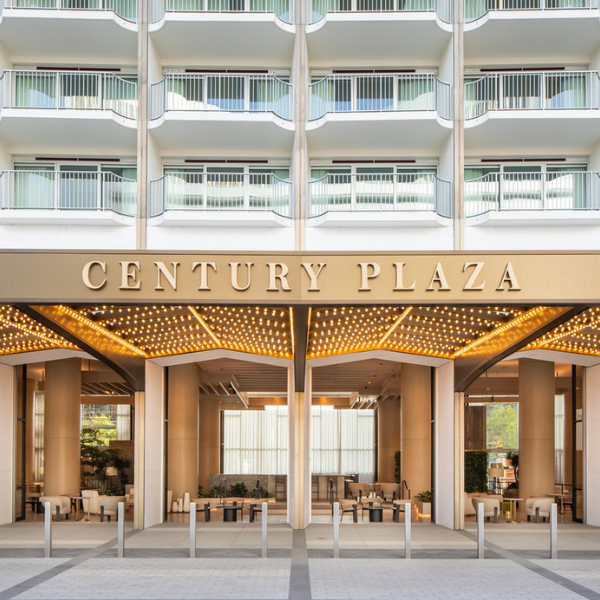 |
Set on the former backlot of 20th Century Fox Studios in Los Angeles, California, it is no surprise that major moments in history have taken place in the storied ballroom of the Fairmont Century Plaza, from the Emmys to the Grammys to a state dinner hosted by President Richard Nixon. Originally dubbed “The Hotel of the Future,” Fairmont Century Plaza has a long history as a cultural epicenter. On the evening of August 13, 1969, President Richard Nixon and First Lady Patricia Nixon hosted the first Presidential State Dinner outside of the White House. Also known as the “Dinner of the Century,” the evening honored the safe return of the Apollo 11 astronauts. 1,440 people attended the star-studded gala, including more than 50 members of Congress, representatives from 83 foreign nations, and 14 members of the president’s Cabinet. Also in attendance were the Apollo 11 astronauts’ families, space and aviation pioneers, space-related committees, and the greatest stars of Hollywood. The “Dinner of the Century” gathered the likes of Mrs. Lillian Disney, Ed and Don Nixon, Justice Warren E. Burger, Buddy Rodgers, and the widows of the astronauts of Apollo 1, all in one room. While every President since Gerald Ford has stayed at Fairmont Century Plaza or visited in some capacity, the hotel is perhaps most closely associated with President Ronald Reagan, a former Hollywood actor who hosted many of his fundraisers and inaugural celebrations in the storied ballroom. During this time, the hotel was frequently referred to as the “Western White House.” The Fairmont Century Plaza was inducted into Historic Hotels of America in 2022. |
"Historic Hotels of America members preserve the history that captures key moments in the lives of U.S. Presidents over the past 230 years," said Lawrence P. Horwitz, Executive Vice President, Historic Hotels of America and Historic Hotels Worldwide. "The United States is a vast nation and presidents travel great distances in their lives—before, during, and after being in office—to connect with millions of voters and local leaders. As transportation used by U.S. Presidents has changed over the past 230 years from horse carriages, sailing and then steam ships, to trains and automobiles, to travel by air, U.S. Presidents have increased the frequency and destinations visited during these trips. Cultural travelers who want to immerse themselves in the history of these iconic destinations can do so with confidence by selecting Historic Hotels of America member hotels, inns, and resorts. A presidential seal of approval makes the stay that much better."
Read more:
The 2023 Top 25 Historic Hotels of America® Most Magnificent Art Collections
2023 Top 25 Historic Hotels of America® Most Historic Golf Courses
The 2023 Top 25 Historic Hotels of America Most Magnificent Ceilings and Domes
The 2023 Top 25 Historic Hotels of America Most Magnificent Gardens
The 2023 Top 25 Historic Hotels of America Where Women Made History
The 2023 Top 25 Historic Hotels of America in Film and Television History
The 2023 Historic Hotels of America Top 25 Afternoon Teas
Read all of our Top 25 Lists here!






















